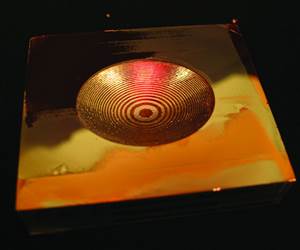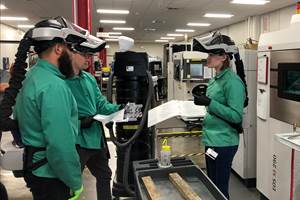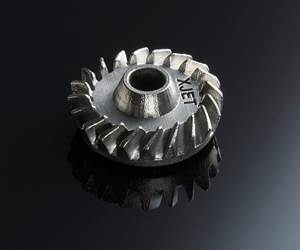To Succeed With Additive, See It As More Than Just Another Method of Making Parts
A fundamental challenge of AM relates to mindset: recognizing it as not just a manufacturing method but also a choice with far-reaching impacts.
For the maker of the Periscope Case, additive manufacturing (AM) proved to be—strangely—a sales and distribution technology. AM’s lack of tooling enabled cost-effective production of this smartphone case at smaller quantities than other processes. The ease of design changes enabled a different mode of responding to market feedback than other production processes would permit. All this enabled a go-to-market strategy different than what would otherwise be possible, and this strategy in turn enabled the case to exist as a viable product. The physical part could be produced some other way, the design could be realized some other way, the material properties could be achieved some other way, but the possibilities for reaching buyers is where additive had its most important impact.
The case is just one product being marketed by one small company. However, much the same phenomenon applies across the scale of a large established enterprise, as our recent piece addressing CEOs explores. To see AM as being just a part-making resource is largely to fail to see it. As the article describes, AM is also a technology advancing cash flow, design, the lean enterprise, logistics, and the realization of company values. It potentially has so many impacts that simply anticipating the impacts is one of its challenges.
There is this term I dislike, a term I wish had never come into use: "subtractive manufacturing." When additive became a thing, beginning to describe the long-existing process of machining for material removal as "subtractive" manufacturing seemed logical. Yet this term is false precisely because of the way it impedes the challenge of fully seeing additive manufacturing’s impacts. Machining and additive are not equivalent opposites; an additive machine or system is not simply a different kind of machine tool that adds material rather than removing it. An additive machine or system is not a machine tool at all, because it occupies such a different role. Whereas a machine tool performs precise cutting on existing workpieces, the additive system potentially replaces casting by building the part from scratch; potentially replaces assembly by consolidating several pieces into one form; potentially saves material cost and future operating cost by improving the mass or thermodynamics of the component; and then, to some extent, probably still needs machining in order to be complete. Taken together, this is something very different from being equivalent to a machine tool, molding press or any other conventional piece of industrial hardware. As our CEO article makes clear, getting out of the box of seeing AM that way, and asking the organization to see it a different way as well, is potentially the beginning of accurately discerning the opportunities additive presents.
So how do we evaluate AM? How do we understand it for what it is? These are questions that do not have immediate easy answers, because the start of our answers always employs the language, context and expectations built upon centuries-old manufacturing processes. And to say "centuries-old" is no disparagement but rather a hint at the scope of the challenge. We in manufacturing have spent generations living with, and building products and supply chains upon, certain fundamental industrial processes for making things. We have refined and advanced those processes but have not changed them. And now, here we are, the first generation to confront this entirely new modality for making parts.
No wonder the way is difficult. No wonder adoption faces hurdles. No wonder we are discovering the learning curve with the technology can be steeper and stranger than we thought. The very role, impact and promise of additive is liable to be not what we thought it would be; it is liable to be more. With additive, the most basic step—the step that eventually has to be taken—is to ask again, and see clearly, just what this technology is and what it wants to be.
Related Content
Understanding HP's Metal Jet: Beyond Part Geometry, Now It's About Modularity, Automation and Scale
Since introducing its metal binder jetting platform at IMTS in 2018, HP has made significant strides to commercialize the technology as a serial production solution. We got an early preview of the just-announced Metal Jet S100.
Read MoreAM 101: What is Ultrasonic Additive Manufacturing?
Going from additive to subtractive can be simple with Ultrasonic Additive Manufacturing (UAM). What is it and how does it work? Learn the basics in this 101 post.
Read MoreHow to Pursue a Career in Additive Manufacturing
AM professionals are in demand as 3D printing matures and advances. But what skills are hiring manufacturers looking for? How can applicants prepare? And where can you find relevant job listings?
Read MoreAM 101: NanoParticle Jetting (NPJ)
The proprietary process from XJet builds ceramic and metal parts using nanoparticle suspensions. Learn how NPJ works in this introductory article, part of our AM 101 series.
Read MoreRead Next
Niche Manufacturer Discovers How Additive and Amazon Go Together
The economics of 3D printing allow for cost-effective production of niche products, and Amazon Prime offers a way to distribute them. The Periscope Case is one company’s first venture into an all-new model aimed at bringing products to market that would never have been profitable before.
Read More3D Printing Brings Sustainability, Accessibility to Glass Manufacturing
Australian startup Maple Glass Printing has developed a process for extruding glass into artwork, lab implements and architectural elements. Along the way, the company has also found more efficient ways of recycling this material.
Read MoreAt General Atomics, Do Unmanned Aerial Systems Reveal the Future of Aircraft Manufacturing?
The maker of the Predator and SkyGuardian remote aircraft can implement additive manufacturing more rapidly and widely than the makers of other types of planes. The role of 3D printing in current and future UAS components hints at how far AM can go to save cost and time in aircraft production and design.
Read More





















